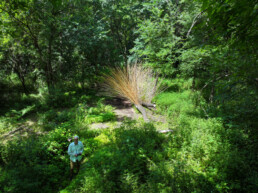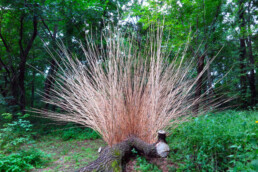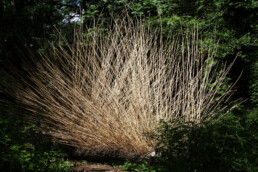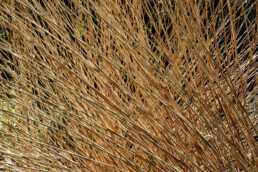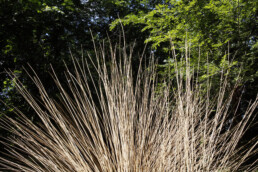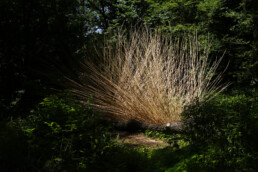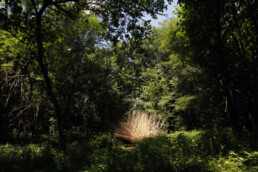CREEPY _ CRAWLY _ SPIKY
Installation at the Linda and Gene Farley Center for Peace, Justice & Sustainability Cemetery
Verona, WI
2025
The environmental message of this highly invasive reed grass, Phragmites australis subsp. australis, piggy backing a ride on a native fallen white oak is obvious.
But is it?
Is there some sort of playful camaraderie going on? Does the beauty of this piece give some insight into non-native species? And isn’t nature by design, an ever-evolving battle ground of native vs. non-native, including US?
Fred Pearce in his book The New Wild, argues that this fear of alien species is “little more than green xenophobia” which leads us to a “dangerous mythology of how nature works. Real nature is often random, temporary, and constantly being remade by fire, flood and disease – with species coming and going, fitting in, adapting, or losing out.”
Humans have had an irreversible impact on the planet’s ecosystems for tens of thousands of years, and nature only responds to this by going forward. Of course, in this Anthropocene era these changes have been multiplied exponentially in direct correlation to man’s ability to travel and exploit the environment. Mr. Pearce believes that we should celebrate nature’s dynamism and power of recovery from human disrupted ecosystems and “true environmentalists should be applauding the invaders”.
Did you know that the entire plant of Phragmites australis subsp. australis is edible raw or cooked and offers several benefits including its use in traditional building materials, food, and medicinal applications. The young stems can be boiled or later used to make flour. Stems can be made into eco-friendly drinking straws and can also be used as bio-friendly roofing material. They grow up to 20’ a season and are a renewable biofuel.
So, the question still remains, Friend or Foe?
Other phragmites benefits:
- Traditional Building Materials: Phragmites stems are used to create reed panels for walls and roofing, and its hollow stalks can be processed into insulation.
- Food and Forage: The plant is edible, with young stems used for flour, and the roots can be prepared similarly to cattails. The entire plant can be given as forage to bovines to treat diarrhea.
- Medicinal Uses: Various parts of the plant have been used traditionally for treating conditions like bronchitis, cholera, food poisoning, and more.
- Erosion Control: Its dense root systems and tall stalks help stabilize soil and reduce wave action, making it valuable in mitigating coastal erosion.
- Wetland Ecosystem Health: Phragmites can provide ecosystem services like nutrient sequestration, soil stabilization, and waste treatment.
- Wildlife Cover: It provides cover for wetland wildlife species.
- Water Filtration: Its root hairs are effective at filtering impurities in wastewater.
